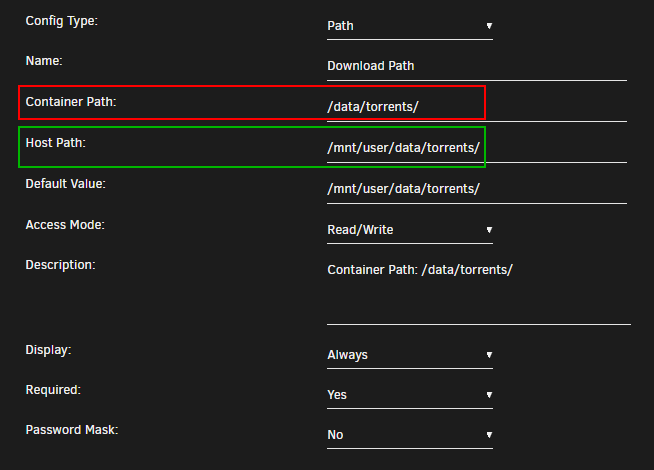Unraid
Note
The first thing you need to do is forget the suggested paths from the Spaceinvader One YouTube Tutorials,
and don't use the predefined paths from the unraid templates.
(Spaceinvader One YouTube guides are great to learn how to start with unraid or how to setup certain applications, and yes I did and still do use them. Probably the main reason why he's using those path is because they are predefined in the template)
Preparation
Make sure hardlinks support is enabled in your Settings => Global Share Settings.
Create the main share
To get Hardlinks and Atomic-Moves working with Unraid,
You will need to make use of ONE share with subfolders.
For this example I'm using my own setup and preferred share data.
Go to your dashboard and on the top select shares select add share .
- use
data - if you got a cache drive and want to make use of it put it on
Yesor keep it disabled (Hardlinks will stay in tact if you're using the cache) - click on
ADD SHARE
Note
Keep in mind regarding the use of the Cache drive, The mover can't move files that are in use, like when seeding with torrents. You will need to stop/pause the torrents so the mover can move them to your Array.
If you use qBittorrent you can automate the process by following the following Guide HERE
With Usenet you won't have any issues.
Folder Structure
On the host (Unraid) you will need to add /mnt/user before it. So /mnt/user/data
The data folder has sub-folders for torrents and usenet and each of these have sub-folders for tv, movie and music downloads to keep things neat. The media folder has nicely named TV, Movies and Music sub-folders, this is your library and what you’d pass to Plex, Emby or JellyFin.
These subfolders you need to create your self, you can use krusader or winscp to create them or any other way you prefer.
data
├── torrents
│ ├── books
│ ├── movies
│ ├── music
│ └── tv
├── usenet
│ └── complete
│ ├── books
│ ├── movies
│ ├── music
│ └── tv
└── media
├── books
├── movies
├── music
└── tv
I'm using lower case on all folder on purpose, being Linux is case sensitive.
Breakdown of the Folder Structure
Bad path suggestion
The default path setup suggested by some docker developers that encourages people to use mounts like /movies, /tv, /books or /downloads is very suboptimal and it makes them look like two or three file systems, even if they aren’t (Because of how Docker’s volumes work). It is the easiest way to get started. While easy to use, it has a major drawback. Mainly losing the ability to hardlink or instant move, resulting in a slower and more I/O intensive copy + delete is used.
Setting up the containers
After you created all the needed folders it's time to setup the paths in the docker containers.
Go to your dashboard and select your docker container you want to edit or if you're starting fresh add the docker containers you want to use or prefer.
Unraid makes it actually pretty clear what's the Host Path and what's the Container Path.
Container Path: => The path that will be used inside the container.
Host Path: => The path on your Unraid Server (The Host).
Torrent clients
qBittorrent, Deluge, ruTorrent
Container Path: => /data/torrents/
Host Path: => /mnt/user/data/torrents/
Info
The reason why we use /data/torrents/ for the torrent client is because it only needs access to the torrent files. In the torrent software settings, you’ll need to reconfigure paths and you can sort into sub-folders like /data/torrents/{tv|movies|music}.
data
└── torrents
├── books
├── movies
├── music
└── tv
Usenet clients
NZBGet or SABnzbd
Container Path: => /data/usenet/
Host Path: => /mnt/user/data/usenet/
Info
The reason why we use /data/usenet/ for the usenet client is because it only needs access to the usenet files. In the usenet software settings, you’ll need to reconfigure paths and you can sort into sub-folders like /data/usenet/{tv|movies|music}.
data
└── usenet
└── complete
├── books
├── movies
├── music
└── tv
The Starr Apps
Sonarr, Radarr and Lidarr
Container Path: => /data
Host Path: => /mnt/user/data/
Info
Sonarr, Radarr and Lidarr gets access to everything because the download folder(s) and media folder will look like and be one file system. Hard links will work and moves will be atomic, instead of copy + delete.
data
├── torrents
│ ├── books
│ ├── movies
│ ├── music
│ └── tv
├── usenet
│ └── complete
│ ├── books
│ ├── movies
│ ├── music
│ └── tv
└── media
├── books
├── movies
├── music
└── tv
Media Server
Plex, Emby, JellyFin and Bazarr
Container Path: => /data/media
Host Path: => /mnt/user/data/media/
Info
Plex, Emby, JellyFin and Bazarr only needs access to your media library, which can have any number of sub folders like Movies, Kids Movies, TV, Documentary TV and/or Music as sub folders.
data
└── media
├── movies
├── music
├── books
└── tv
Final Result
Don't forget to look at the Examples how to setup the paths inside your applications.
Video Tutorial
Big Thanks to IBRACORP for noticing this Guide and creating a Video covering this unraid section.
The reason why I added the video to the end is because I want the user to actually learn and understand why it's recommended to use this folder structure, before going straight to the YouTube video.
Also check out other videos from IBRACORP HERE
Questions or Suggestions?
If you have questions or suggestions click the chat badge to join the Discord Support Channel where you can ask your questions directly and get live support.







